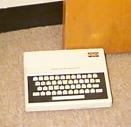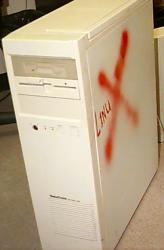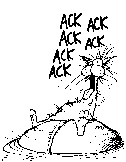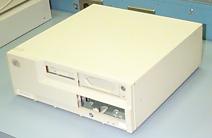 My other favourite stress-reliever is The Dammit Doll
(left). The instructions read:
My other favourite stress-reliever is The Dammit Doll
(left). The instructions read:
Some of these I bought myself, some I received from generous publishers. In May 1998, my esteemed colleague Jim Tucker donated his entire library of UNIX books. Since I'm a UNIX geek, I gladly accepted, and opened the annex, which I have christened The James Tucker UNIX Library Annex in honour of Jim. A few books are out-of-date. So much to read, so little time...
I use a heap-based filing system, where various notes, papers, diskettes and other junk are piled in several heaps throughout the office. A heap-based filing system features short insertion times and the ability to create new heaps dynamically (limited only by available flat surfaces), albeit at the expense of (sometimes very) long retrieval times. And once in a while, I have to run an extensive (and resource-intensive) garbage collection routine, usually at the end of the term.
This is where I like to hang out when I'm not teaching. It provides a flat surface for recently-used filing-system heaps and for my computer. I currently have a Sun Microsystems Ultra 10 workstation, with 256 MB of RAM and 9 GB of hard disk. The machine also has a SunPCI card installed, containing a 300 MHZ AMD K6-2 processor and its own 64 MB of RAM. This card lets me run Windoze NT 4.0 in a window under Solaris. That way, when NT inevitably crashes, I just close the window and restart. As of August 31, 2001, my box was experiencing a 118-day uptime.
Also hooked up to my machine are a 21-inch Sun monitor, JBL powered speakers, an Iomega parallel-port Zip drive, and an Epson Stylus Color 600 printer. St. Dogbert sits on top of the monitor to drive out the "demons of stupidity".
My previous computer is a 233 MHz Pentium II system, with 64 MB of RAM, 4 GB of removable SCSI hard disk, IDE DVD/CD-ROM drive, LS-120 SuperDisk floppy drive, ATI 3D Rage Pro AGP video, 15-inch Princeton EO50 monitor, 3COM 3C905B and 3C509B Ethernet cards, and SoundBlaster 16. It has been transformed into a transportable, via a Samsonite luggage cart. Here's one view. Here's another view of it hooked up to a Princeton EO50 monitor, running Red Hat Linux 6.0 (no X). I use this box for lectures, so that I can do "live demonstrations", for example, changing code and recompiling on the spot. I usually run Windows NT 4.0 Workstation, but I have Windoze 95 installed (for playing Quake over the network), Solaris 7 x86, and, of course, Linux (Slackware 7.0 and Red Hat 6.0).
Lets in ACTUAL SUNLIGHT!!! Something that I rarely saw working in a veal-fattening pen (i.e., cubicle) in my previous career. The view's not much, but at least there is one!
Generously donated to the college by a major Canadian bank, this 33-MHz, MIPS R2000-based DECStation 3100 was a powerful RISC workstation in its heyday. Unfortunately, the Ultrix (UNIX) operating system that is installed has some bad blocks on one of its disk partitions, I have no documentation on how to fix it, and the personnel who used to administer the machine at the bank are no longer employed there. Furthermore, Digital Equipment Corp. got swallowed by Compaq. So now, it is my DECHeater 3100, because its three system units and 17-inch monitor will warm up my office on those cold days when they forget to turn on the heat in our wing of the college.
I must hold the record at the college for running the most operating systems. Most of these drives are SCSI, a couple are IDE. Each one has a different O/S installed: Windows 95, NT 4.0 Server and NT 4.0 Workstation; OS/2 Warp; Slackware Linux 3.2, 3.4 and 7.0; Red Hat Linux 6.0; Solaris x86 7; NetWare 3.12 and 4.11; FreeBSD 2.2.2; and last, but not least, (because it runs Quake) MS-DOS 6.20. I hope to add another half-dozen or so in the future!
All of these CD-ROMs are useful in some way. Linux, CD-Rs containing backups and files from previous terms, CD-ROMs from books, software, etc. All of the useless CD-ROMs get drilled and turned into keychains, such as those from AOL and MSN, Visual J++, old C compilers, etc.
This has to be the hardest padded office chair I have ever sat on! (My butt is very sensitive due to long hours sitting in front of the computer or TV -- my chair cost me over $300 and is very comfortable!). Feel free to visit me, the hard chair is not intended to drive you away quickly!
An ACTUAL DOOR... THAT LOCKS... AND I HAVE THE KEY!!! Another perk that I would only get in the RealWorldTM if I was a vice-president or some other kind of a**hole. If my door is open, feel free to "bug" me. If it's locked and the lights are on, knock -- I'm (a) ignoring you and/or (b) missing and presumed elsewhere.

Another neat aspect of having my own door is that I can use any doorstop I like. My doorstop of choice, graciously donated by my esteemed colleague Mark Csele is a Tandy/Radio Shack TRS-80 Model MC-10 Micro Color Computer, Serial # 500003. It is presently set to Channel 3.
Originally, there were three, but since only one has survived. A manufacturing company in Burlington, Ontario, generously donated two of these boxes, while the other was generously donated by a large corporation located right here in Welland. They were named using a Bloom County motif.


ack was a DataTrain 4425 EISA system, a 486SX/25 with 8 MB of RAM, two IDE hard disks (105 MB and 425 MB, although due to BIOS restrictions only 100 MB and 202 MB is actually useable), and an HP EtherPlus network card. Don't let the large case fool you, it's the baby of the bunch, and just goes to show the kind of crappy hardware that Linux will run on, including Apache, Samba, and more. ack was originally installed in an industrial plant environment -- I wasted a can of canned air and several yards of paper towels cleaning all the sh*t (dust, oily dirt, metal shavings) from it! The spray-painted X was part of the equipment disposal policy of the company that donated the box; first I added Linux and then I added the "L-I-N-U".

thpfft (yes, you read that right, T-H-P-F-F-T, a form of expression exhibited by Bill the Cat) was a Compaq ProLinea 4/50 containing a 486DX2/66 with 16 MB of RAM, 540 MB of IDE disk, and an HP EtherPlus network card. It's ack's big brother.


opus (ironically, the name of a penguin) is an IBM PS/2 ValuePoint 100DX4/Dp system, a 486DX2/66 with 16 MB of RAM, Adaptec 1542 SCSI controller, 340 MB and 1 GB SCSI hard disks, and (you guessed it) an HP EtherPlus network card. All three of these machines have been used in student labs here, and we hope to continue our "Linux experiments" for years to come. The price is right (free, about $30 CDN to buy CDs), it's rich-featured, it ships with source code, and (most importantly) Linux DOESN'T CRASH if you look at it the wrong way!
I needed more flat surfaces for my heap-based filing system and for the plethora of UNIX books that I inherited. I already had a shelf; I just needed supports. So I used some leftover Panduit plastic conduit, normally used as cable raceways. Amazing stuff! Special thanks also go out to my sturdy Digital Equipment Corporation workstation, and to the Planet Earth, for its much maligned, yet wonderfully useful Force Of Gravity.
Used mainly for interesting news articles, important college memos and documents, my collection of funny Dilbert comics, my goddaughter's artwork, and an in-concert black-and-white 8-by-10 of my personal guitar god, Edward Van Halen. And, oh yeah, the digitally-manipulated image of my head and my colleague Mark Csele's head, superimposed on an actual image of The Crusher and Dick The Bruiser, two legendary pro wrestlers of the 1970's. I think sometimes our students feel like they're getting beat up! :-)
The east-facing wall (not shown above) is what I like to call "The Wall of Despair". All of these "demotivators" were taken from the 2000 calendar offered by Despair, Inc.. I find that they present a very realistic outlook (as opposed to the idealistic, utopian-wannabe other kind).
 My other favourite stress-reliever is The Dammit Doll
(left). The instructions read:
My other favourite stress-reliever is The Dammit Doll
(left). The instructions read:
When you'd like to kick the dog or throw the phone and shout here's a little Dammit doll That you can't live without Just grasp it firmly by its leg and find a place to slam it And as you whack its stuffing out Yell Dammit, Dammit, Dammit!!
 Back to Mike's home page |
Online 1999/01/21 |
Updated |
tourists and counting |